Download CBSE Class 11 Computer Science Flow of Control Notes in PDF format. All Revision notes for Class 11 Computer Science have been designed as per the latest syllabus and updated chapters given in your textbook for Computer Science in Class 11. Our teachers have designed these concept notes for the benefit of Class 11 students. You should use these chapter wise notes for revision on daily basis. These study notes can also be used for learning each chapter and its important and difficult topics or revision just before your exams to help you get better scores in upcoming examinations, You can also use Printable notes for Class 11 Computer Science for faster revision of difficult topics and get higher rank. After reading these notes also refer to MCQ questions for Class 11 Computer Science given on studiestoday
Revision Notes for Class 11 Computer Science Chapter 6 Flow of Control
Class 11 Computer Science students should refer to the following concepts and notes for Chapter 6 Flow of Control in Class 11. These exam notes for Class 11 Computer Science will be very useful for upcoming class tests and examinations and help you to score good marks
Chapter 6 Flow of Control Notes Class 11 Computer Science
Decision Making and branching (Conditional Statement)
Looping or Iteration
Jumping statements
4.1 DECISION MAKING & BRANCHING
Decision making is about deciding the order of execution of statements based on certain conditions. Decision structures evaluate multiple expressions which produce TRUE or FALSE as outcome.

There are three types of conditions in python:
1.if statement
2.if-else statement
3.elif statement
4.if statement: It is a simple if statement. When condition is true, then code which is associated with if statement will execute.
Example:
a=40
b=20
if a>b:
print(“a is greater than b”)
5.if-else statement: When the condition is true, then code associated with if statement will execute, otherwise code associated with else statement will execute.
Example:
a=10
b=20
if a>b:
print(“a is greater”)
else:
print(“b is greater”)
elif statement: It is short form of else-if statement. If the previous conditions were not true, then do this condition”. It is also known as nested if statement.
Example:
a=input(“Enter first number”)
b=input(“Enter Second Number:”)
if a>b:
print(“a is greater”)
elif a==b:
print(“both numbers are equal”)
else:
print(“b is greater”)
4.2 LOOPS in PYTHON
Loop: Execute a set of statements repeatedly until a particular condition is satisfied.
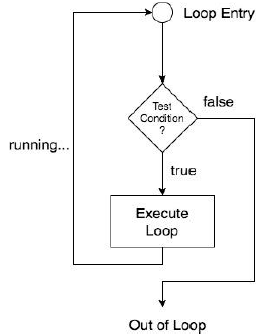
There are two types of loops in python:
1. while loop
2. for loop
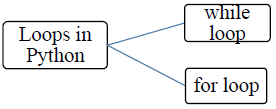
while loop: With the while loop we can execute a set of statements as long as a condition is true. It requires to define an indexing variable.
Example: To print table of number 2
i=2
while i<=20:
print(i)
i+=2
for loop : The for loop iterate over a given sequence (it may be list, tuple or string).
Note: The for loop does not require an indexing variable to set beforehand, as the for command itself allows for this. primes = [2, 3, 5, 7]
for x in primes:
print(x)
The range( ) function:
it generates a list of numbers, which is generally used to iterate over with for loop. range( ) function uses three types of parameters, which are:
- start: Starting number of the sequence.
- stop: Generate numbers up to, but not including last number.
- step: Difference between each number in the sequence.
Python use range( ) function in three ways:
a. range(stop)
b. range(start, stop)
c. range(start, stop, step)
Note:
- All parameters must be integers.
- All parameters can be positive or negative.
a. range(stop): By default, It starts from 0 and increments by 1 and ends up to stop, but not including stop value. Example: for x in range(4): print(x)
Output:
0
1
2
3
b. range(start, stop): It starts from the start value and up to stop, but not including stop value.
Example: for x in range(2, 6): print(x)
Output:
2
3
4
5
c. range(start, stop, step): Third parameter specifies to increment or decrement the value by adding or subtracting the value.
Example: for x in range(3, 8, 2): print(x)
Output:
3
5
7
Explanation of output: 3 is starting value, 8 is stop value and 2 is step value. First print 3 and increase it by 2, that is 5, again increase is by 2, that is 7. The output can’t exceed stop-1 value that is 8 here. So, the output is 3, 5, 8.
Difference between range( ) and xrange( ):
| xrange( ) | ||
| returns the list of numbers | returns the generator object that can be used to display numbers only by looping | ||
| The variable storing the range takes more memory | variable storing the range takes less memory | ||
| all the operations that can be applied on the list can be used on it | operations associated to list cannot be applied on it | ||
| slow implementation | faster implementation |
4.3 JUMP STATEMENTS:
There are two jump statements in python:
break
continue
break statement : With the break statement we can stop the loop even if it is true.
Example:
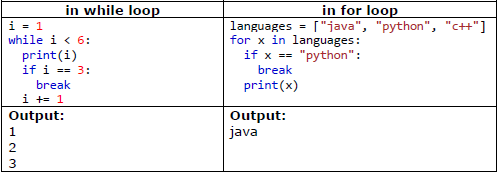
Note: If the break statement appears in a nested loop, then it will terminate the very loop it is in i.e. if the break statement is inside the inner loop then it will terminate the inner loop only and the outer loop will continue as it is.
continue statement : With the continue statement we can stop the current iteration, and continue with the next iteration.
Example:
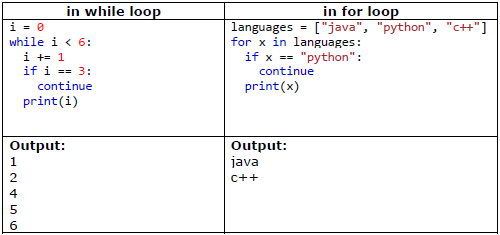
4.4 Loop else statement:
The else statement of a python loop executes when the loop terminates normally. The else statement of the loop will not execute when the break statement terminates the loop.
The else clause of a loop appears at the same indentation as that of the loop keyword while or for.
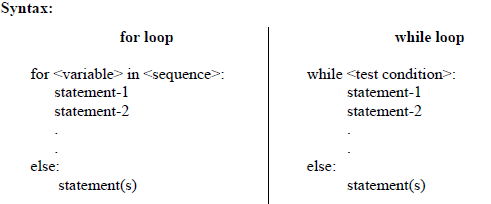
4.5 Nested Loop :
A loop inside another loop is known as nested loop.
Syntax:
for in :
for in :
statement(s)
statement(s)
Example:
for i in range(1,4):
for j in range(1,i):
print(“*”, end=” “)
print(” “)
Programs related to Conditional, looping and jumping statements
1.Write a program to check a number whether it is even or odd.
num=int(input(“Enter the number: “))
if num%2==0:
print(num, ” is even number”)
else:
print(num, ” is odd number”)
2.Write a program in python to check a number whether it is prime or not.
num=int(input(“Enter the number: “))
for i in range(2,num):
if num%i==0:
print(num, “is not prime number”)
break;
else:
print(num,”is prime number”)
3.Write a program to check a year whether it is leap year or not.
year=int(input(“Enter the year: “))
if year%100==0 and year%400==0:
print(“It is a leap year”)
elif year%4==0:
print(“It is a leap year”)
else:
print(“It is not leap year”)
4.Write a program in python to convert °C to °F and vice versa.
a=int(input(“Press 1 for C to F \n Press 2 for F to C \n”))
if a==1:
c=float(input(“Enter the temperature in degree celcius: “))
f= (9/5)c+32
print(c, “Celcius = “,f,” Fahrenheit”)
elif a==2:
f=float(input(“Enter the temperature in Fahrenheit: “))
c= (f-32)5/9
print(f, “Fahrenheit = “,c,” Celcius”)
else:
print(“You entered wrong choice”)
5.Write a program to check a number whether it is palindrome or not.
num=int(input(“Enter a number : “))
n=num
res=0
while num>0:
rem=num%10
res=rem+res*10
num=num//10
if res==n:
print(“Number is Palindrome”)
else:
print(“Number is not Palindrome”)
6.A number is Armstrong number or not.
num=input(“Enter a number : “)
length=len(num)
n=int(num)
num=n
sum=0
while n>0:
rem=n%10
sum=sum+rem**length
n=n//10
if num==sum:
print(num, “is armstrong number”)
else:
print(num, “is not armstrong number”)
7.To check whether the number is perfect number or not
num=int(input(“Enter a number : “))
sum=0
for i in range(1,num):
if(num%i==0):
sum=sum+i
if num==sum:
print(num, “is perfect number”)
else:
print(num, “is not perfect number”)
8.Write a program to print Fibonacci series.
n=int(input(“How many numbers : “))
first=0
second=1
i=3
print(first, second, end=” “)
while i<=n:
third=first+second
print(third, end=” “)
first=second
second=third
i=i+1
9.To print a pattern using nested loops
for i in range(1,5):
for j in range(1,i+1):
print(j,” “, end=” “)
print(‘\n’)

| CBSE Class 11 Computer Science Flow of Control Notes |
| CBSE Class 11 Computer Science Functions Notes Set A |
| CBSE Class 11 Computer Science Functions Notes Set B |
CBSE Class 11 Computer Science Chapter 6 Flow of Control Notes
We hope you liked the above notes for topic Chapter 6 Flow of Control which has been designed as per the latest syllabus for Class 11 Computer Science released by CBSE. Students of Class 11 should download and practice the above notes for Class 11 Computer Science regularly. All revision notes have been designed for Computer Science by referring to the most important topics which the students should learn to get better marks in examinations. Our team of expert teachers have referred to the NCERT book for Class 11 Computer Science to design the Computer Science Class 11 notes. After reading the notes which have been developed as per the latest books also refer to the NCERT solutions for Class 11 Computer Science provided by our teachers. We have also provided a lot of MCQ questions for Class 11 Computer Science in the notes so that you can learn the concepts and also solve questions relating to the topics. We have also provided a lot of Worksheets for Class 11 Computer Science which you can use to further make yourself stronger in Computer Science.
You can download notes for Class 11 Computer Science Chapter 6 Flow of Control for latest academic session from StudiesToday.com
Yes, the notes issued for Class 11 Computer Science Chapter 6 Flow of Control have been made available here for latest CBSE session
There is no charge for the notes for CBSE Class 11 Computer Science Chapter 6 Flow of Control, you can download everything free of charge
www.studiestoday.com is the best website from which you can download latest notes for Chapter 6 Flow of Control Computer Science Class 11
Come to StudiesToday.com to get best quality topic wise notes for Class 11 Computer Science Chapter 6 Flow of Control

